When filling out an Artwork Release form, individuals sometimes make errors that can lead to complications. One common mistake is not reading the instructions carefully. Each section has specific requirements, and overlooking them can result in incomplete or incorrect submissions.
Another frequent error is forgetting to sign the form. A signature is crucial as it indicates consent. If the form is submitted without a signature, it may be rendered invalid, causing delays in the intended use of the artwork.
Providing inaccurate information is also a common issue. This might include misspellings of names, incorrect contact details, or wrong dates. Such discrepancies can complicate communication and verification processes.
People often neglect to specify the scope of use for the artwork. It’s important to outline how the artwork will be used, whether for commercial or non-commercial purposes. Without this information, misunderstandings may arise later on.
Another common mistake is failing to include the necessary attachments, such as the artwork itself or any relevant exhibits. These supporting documents are essential for the reviewing party to assess the work appropriately.
Some individuals mistakenly believe that the terms of the release can be altered after submission. However, any changes typically require a new, signed form to ensure legal validity, creating unnecessary work and potential disputes.
Misunderstanding the rights being relinquished can lead to confusion. The form typically outlines what rights the artist gives up versus what rights they retain. A clear understanding of this distribution is essential to avoid future conflicts.
Lastly, people often overlook the importance of keeping a copy of the signed form for their records. Having a documented copy serves as a reference for both the artist and the recipient and can prevent potential disputes regarding terms or consent.
